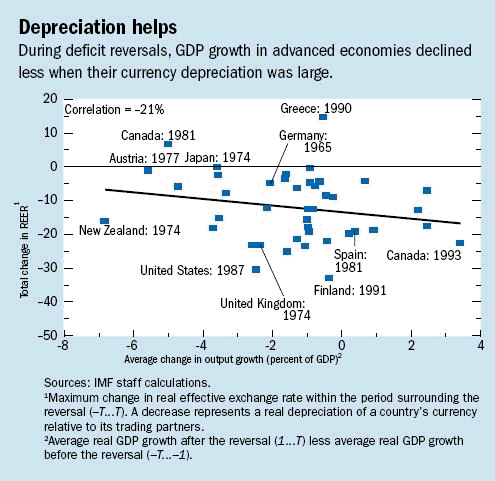
Typical street scene in Santa Ana, El Salvador. (Photo: iStock)
IMF Survey: In Search of Greater Global Balance
April 11, 2007
- Countries studied over past 40 years to identify external imbalance episodes
- Real exchange rate movements helped smooth rebalancing of demand
- Domestic policies were also important for external adjustment
Some analysts argue that the current large global imbalances—the U.S. deficit and the surpluses of some advanced economies, emerging markets, and oil exporters—can be sustained for a relatively long time.

Container ship in Baltimore, Maryland: WEO addresses U.S. trade volume response to dollar movements (photo: Berle Cherney/SCW)
Rebalancing the WORLD ECONOMY
These analysts believe the imbalances reflect secular changes in the global economy, such as the integration into world markets of countries with large and underutilized labor forces and less rapid aging of the U.S. population compared with many surplus economies. According to this view, the narrowing of the imbalances will depend on a rebalancing of the saving and investment behaviors of the United States and the surplus economies, with exchange rate realignment playing a minor role.
How imbalances can be reduced
The issue: Current large external imbalances are considered potentially risky, but how can they be reduced?
The bottom line: Cross-country experiences suggest that a market-led realignment of real exchange rates, in conjunction with a balancing of demand across countries, can smooth the unwinding of external imbalances.
The debate: There's no real consensus about how long such imbalances can be sustained or the channels through which adjustment takes place.
Others argue that because of the incomplete global integration of markets for goods and services and the rigidities that impede the reallocation of resources to tradable sectors, a narrowing of global imbalances will require a rebalancing of demand between the United States and surplus economies plus considerable movement in real exchange rates to avoid a prolonged U.S. recession.
History sheds some light
Chapter 3 of the IMF's April 2007 World Economic Outlook (WEO) looks at a broad range of countries over the past 40 years to identify episodes of large external imbalances. It then looks at the length of the episodes and the roles real exchange rates and changes in growth differentials played in the adjustment of the imbalances.
The WEO analysis shows that movements of real exchange rates helped smooth the rebalancing of demand involved in the narrowing of external imbalances. According to the analysis, GDP growth declined less in advanced countries undergoing a large and sustained reversal of external deficits when their currency depreciation was relatively large (see chart). Domestic policies were also found to be important for external adjustment. In particular, increases in saving rates and strong fiscal consolidation in deficit countries helped sustain investment and growth rates during the adjustment. For both advanced and emerging market countries, large and sustained reversals of external surpluses tended to entail real currency appreciations. Moreover, when countries' surpluses narrowed, domestic demand generally picked up and monetary and fiscal policies were more expansionary.
U.S. trade balance
The WEO analysis suggests that the U.S. trade balance may be more responsive to changes in the real value of the U.S. dollar (price elasticity of demand) than is often assumed. Standard trade models tend to underestimate this response because they do not account for the large differences in response across sectors or for the extent to which imports include intermediate products that are produced domestically. Furthermore, long-run U.S. trade price elasticity has increased over time, reflecting greater competition among firms in an increasingly globalized economy.

The WEO finds, specifically, that a real depreciation of the U.S. dollar of less than 10 percent could reduce the U.S. trade deficit by 1 percent of GDP. The economics literature, in contrast, generally maintains that a real depreciation of 10-20 percent would be needed to bring about such a reduction in the trade deficit. The current U.S. trade deficit represents about 6½ percent of GDP.
The adjustment of current global imbalances will probably entail a combination of exchange rate movements with a rebalancing of domestic demand—rising rates of absorption in surplus countries and a slower pace of demand growth in the United States. Fiscal consolidation designed to ensure that the U.S. economy is well placed to face the fiscal cost of population aging would also help.







